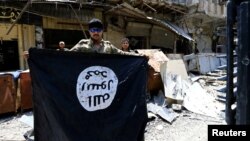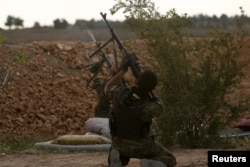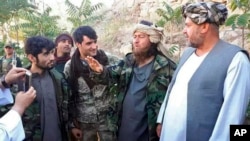Destroying the Islamic State is proving more difficult than the United States and its allies envisioned, with the most recent intelligence assessments warning that the self-declared caliphate is well-positioned to rise again.
For months, U.S. and coalition officials have talked about how the combination of air power and partner forces on the ground cleared the IS terror group, also known as ISIS or Daesh, from about 98 percent of the territory it once held in Syria and Iraq.
But now these same officials admit it is not yet enough.
IS “is well-positioned to rebuild and work on enabling its physical caliphate to re-emerge,” Pentagon spokesman Cmdr. Sean Robertson told VOA in an emailed statement.
“ISIS probably is still more capable than al-Qaida in Iraq at its peak in 2006-2007, when the group had declared an Islamic State and operated under the name Islamic State of Iraq,” Robertson added. “ISIS remains a threat, and even one ISIS fighter is one too many.”
Intelligence estimates
The statement came in response to questions about the latest Defense Department intelligence estimates, which put the number of IS fighters in Iraq and Syria between 28,000 and almost 32,000, close to the types of numbers the terror group boasted at the height of its power.
A separate report this week from the United Nations came to a similar conclusion, estimating there are up to 30,000 IS fighters, split roughly between the two countries.
‘Not a good metric’
The numbers stand in stark contrast with the types of figures and anecdotes the coalition has provided until recently at briefings with reporters, suggesting IS fighters have been backed into a few remaining pockets in Syria, while often “hiding in onesies and twosies” while trying to blend in with local populations.
Some senior U.S. defense and coalition officials have pushed back gently at the new estimates of IS force strength, suggesting the numbers may include not just hardened fighters but family members and sympathizers who lack the will or capability to fight.
But the latest messaging from the Pentagon suggests that even if that is the case, IS is more resilient and more dangerous than many thought possible.
“Yes, there are still residual numbers of ISIS members,” Robertson said, refusing to address the numbers directly. “But manpower is not a good metric to assess the volatility of this terror group.”
“ISIS will take full advantage of any opportunity, including any abatement of pressure, to regain its momentum,” he added.
A challenge to quantify
Getting a handle on the scope of Islamic State’s might and resources has long been a challenge for Western military and intelligence agencies.
To date, the U.S.-led coalition has carried out about 24,000 airstrikes, killing close to 70,000 IS fighters, according to some U.S. military officials.
“That is more than two times the original high-end estimate, and more than three times the original low-end estimate [of IS fighters],” Thomas Joscelyn, a senior fellow at the Foundation for Defense of Democracies told VOA. “It would be impossible for any fighting organization to maintain its cohesion while replacing its entire force structure.”
Yet, if any of the estimates are right, it appears IS has managed to do just that, thanks in part to an influx of upward of 40,000 so-called foreign fighters from more than 40 countries.
Many of those foreign fighters are thought to have been killed, and intelligence officials say the flow of jihadists into Iraq and Syria has been slowed to a trickle, at most.
“The fighters that do remain, they’d be pretty seasoned at this point,” a counterterrorism official told VOA, adding that tracking them, especially in war-torn Syria, is difficult at best.
Others are holed up in the Middle Euphrates River Valley, near Hajin, where U.S.-backed Syrian Democratic Forces are preparing for a final assault.
“I’m not going to speculate on the numbers,” British Army Maj. Gen. Felix Gedney, the coalition’s deputy commander for strategy and support, told Pentagon reporters during a video briefing Tuesday.
“There’s over a thousand we know of,” he added. “We’ll find out when we get there, and we will deal with them all.”
More still would seem to be out of reach for the United States and its coalition partners.
Healthy finances
The latest U.S. military intelligence estimate says the vast majority of IS fighters in Syria, between 8,000 and 9,000 are in regions controlled by Syrian government forces or their Russian or Iranian allies.
The terror group’s finances, while not what they once were, also appear to be in good enough shape.
“Its financial reserves have declined but not dried up,” according to the U.N. report released earlier this week. “One Member State estimates its total reserves to be in the low hundreds of millions of United States dollars.”
The report said IS continues to make money from extortion, kidnapping and taxes, and from oil, having taken advantage of a slowdown in fighting earlier this year to regain access to oil fields in northeastern Syria.
Smuggling routes are also active, despite efforts by coalition partners to crack down.
Just this past week, partner forces captured seven smugglers trying to move five IS fighters in the At-Tanf area of Syria, the coalition said. Last month, 25 Islamic State fighters were captured in the same area.
Sweeps across liberated parts of Iraq also continue to turn up IS fighters by the dozens.
“The ISIS problem is far from over,” said coalition spokesman Col. Sean Ryan.
“We cannot emphasize enough that the threat of losing the gains we have made is real, especially if we are not able to give the people a viable alternative to the ISIS problem,” he warned.












